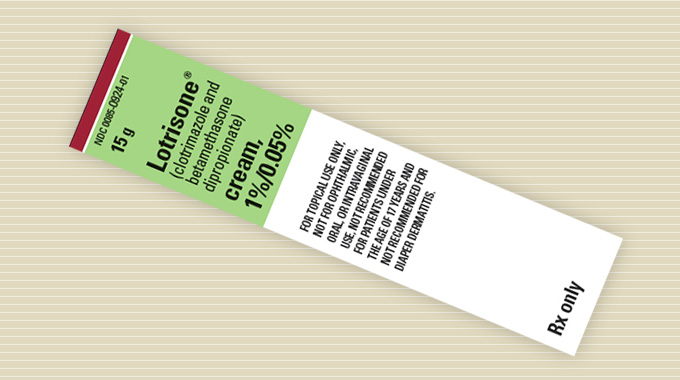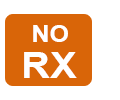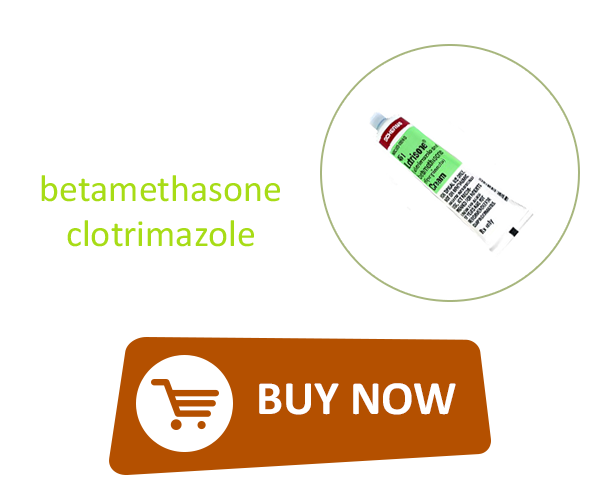Lotrisone (betamethasone/clotrimazole)
The basic name of Lotrisone is clotrimazole or betamethasone dipropionate. This combination drug is used for the treatment of several fungal skin diseases like athlete’s foor, jock itch and ringworm.

Composition
Clotrimazole is chemically an imidazole with the chemical formula C22H17ClN2 and molecular mass of 344.84 g/mol. Clotrimazole is a white, odorless, crystalline powder which is soluble in ethanol and insoluble in water. Betamethasone dipropionate has an empirical formula C28H37FO7 with a molar mass of 504.59 g/mol.
Uses
Lotrisone is used for the topical treatment of inflammatory fungal infections like tinea cruris, tinea corporis and tinea pedis caused by Trichophtyon rubrum ,Trichophyton mentagrophytes, and Epidermophyton floccosum in patients ageing 17 years and above. Lotrisone consists of two medicines. Clotrimazole is an azole antifungal agent which works by stopping the growth of the fungi. Betamethasone is a corticosteroid which works by decreasing the redness, itching and swelling of skin due to infection.
Dosage
The recommended dosage for Lotrisone (clotrimazole and betamethasone) is as follows:
For topical use:
- Clean and dry the affected area before applying the medication.
- Apply a thin layer of Lotrisone cream or ointment to the affected skin and surrounding area.
- Gently rub the cream or ointment into the skin until it is evenly distributed.
- Use Lotrisone once or twice daily, as directed by your healthcare professional.
- Duration of treatment may vary depending on the severity of the condition, so follow the instructions provided by your doctor.
It is important to follow the dosage instructions provided by your healthcare provider. Do not apply Lotrisone to open wounds, and avoid contact with eyes, nose, or mouth. If you have any questions or concerns regarding the appropriate dosage or usage, consult with your doctor or pharmacist for further guidance.
How to use
Hands should be properly washed after the application of the cream on the affected skin. The dosage and duration of the therapy is based on the type of fungal infection. Jock itch or ringworm requires complete 2 weeks to be treated whereas athlete’s foot is usually treated in 4 weeks. The drug should be applied regularly to gain maximum advantages from it.
For the treatment of tinea cruris or tinea corporis:
- Apply a thin layer of the cream on the affected skin region twice in a day for 1 complete week.
- Don’t apply more than 45 grams in a week.
For the treatment of tinea pedis:
- Gently apply required amount of Lotrisone on the affected areas twice daily for 2 weeks.
- Occlusive dressings should be avoided. Do not use this cream for more than 4 weeks.
Lotrisone cream is meant only for topical purpose. The administration of this drug should not be intravaginal, oral or ophthalmic.
Side-Effects
Lotrisone cream may commonly cause dry skin, tingling, burning or stinging effects on the applied skin. Inform your doctor if any of these infrequent but adverse side-effects are observed: skin discoloration/thickening, stretch marks, increased thirst, extreme hair growth, folliculitis or hair bumps, excessive/abnormal tiredness, weight loss, headache, swollen feet/ankles, vision problems, allergic reactions like trouble breathing, rashes, itching or swelling of tongue/face/throat, severe dizziness or increased urination.
Contraindications
Tell your doctor about your allergies to betamethasone or clotrimazole or any other azole antifungal agents like ketoconazole or corticosteroids such as triamcinolone. Let the doctor know about your past medical conditions, especially of: weak blood circulatory system, problems in immune system.
Pregnancy and Lotrisone
This drug should be administered during pregnancy period only when it is clearly required. The risks and advantages of the medication should be discusses with the doctor. It is not clearly known whether the drug is capable of passing into the human milk when applied on the skin. Similar drugs are excreted into the breast milk when taken orally. Therefore it is important to notify the doctor before breastfeeding.
Some frequently asked questions about Clotrimazole and Betamethasone
What is clotrimazole and betamethasone?
Clotrimazole and betamethasone is a combination medication used to treat various fungal infections of the skin. It contains clotrimazole, an antifungal agent, and betamethasone, a corticosteroid that reduces inflammation and itching.
What conditions can clotrimazole and betamethasone treat?
Clotrimazole and betamethasone is commonly used to treat fungal skin infections such as athlete's foot (tinea pedis), jock itch (tinea cruris), and ringworm (tinea corporis). It helps relieve symptoms like itching, redness, and inflammation associated with these conditions.
How does clotrimazole and betamethasone work?
Clotrimazole inhibits the growth of fungi, while betamethasone reduces inflammation and itching. The combination of these two ingredients provides both antifungal and anti-inflammatory effects, helping to treat and relieve symptoms of fungal infections.
Is clotrimazole and betamethasone safe to use?
Clotrimazole and betamethasone is generally safe when used as directed by a healthcare professional. However, it is important to follow the recommended dosage and duration of treatment. Prolonged use or misuse can lead to potential side effects. Consult your doctor if you have any concerns.
Can clotrimazole and betamethasone be used during pregnancy or breastfeeding?
It is advisable to consult a healthcare professional before using clotrimazole and betamethasone during pregnancy or while breastfeeding. They can evaluate the potential risks and benefits and provide guidance based on your specific situation.
How should clotrimazole and betamethasone be applied?
Clean and dry the affected area before applying a thin layer of clotrimazole and betamethasone cream or ointment. Gently massage it into the skin until it is evenly distributed. Follow the instructions provided by your healthcare professional or the product packaging for the appropriate application method and dosage.
How long does it take for clotrimazole and betamethasone to work?
The time it takes for clotrimazole and betamethasone to work can vary depending on the severity of the fungal infection and individual response. Improvement in symptoms can typically be seen within a few days of starting treatment. However, complete resolution may require several weeks of continuous use.
Can clotrimazole and betamethasone interact with other medications?
Clotrimazole and betamethasone may interact with certain medications. Inform your healthcare professional about all the medications, supplements, or herbal products you are taking to avoid any potential interactions. It is especially important to mention other corticosteroids or antifungal medications.
Can clotrimazole and betamethasone be used for children?
The use of clotrimazole and betamethasone in children should be determined by a healthcare professional. They can assess the child's specific condition and provide appropriate guidance on dosage and usage.
What should I do if my symptoms do not improve or worsen?
If your symptoms do not improve or worsen despite using clotrimazole and betamethasone as directed, it is recommended to consult a healthcare professional for further evaluation and guidance. They can assess your condition and recommend alternative treatment options if necessary.



